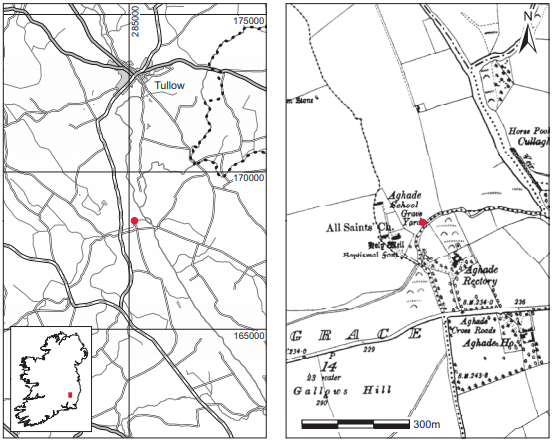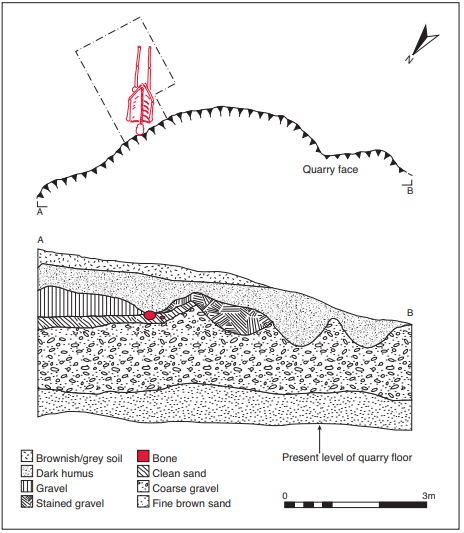1949:007 - AGHADE, CO. CARLOW, Carlow
County: Carlow
Site name: AGHADE, CO. CARLOW
Sites and Monuments Record No.: SMR CW 013-056
Licence number: E1031
Author: P.J. HARTNETT
Author/Organisation Address: —
Site type: Graves of indeterminate date
Period/Dating: —
ITM: E 685111m, N 668490m
Latitude, Longitude (decimal degrees): 52.760754, -6.738974
Introduction
In August 1949 a number of extended inhumation burials were discovered in a gravel quarry being operated by Carlow County Council near the village of Ballon, Co. Carlow. Workers had noticed human bone some weeks before the discovery was reported, so that by the time the site was investigated the burials were heavily disturbed. Burials were found between 0.3m and 1.5m below ground level. The site was reported to the NMI by the Garda Síochána at Ballon, Co. Carlow. It was investigated in early September 1949, and again later that month, by P.J. Hartnett. The human remains were analysed by Professor E.J. Keenan.
Location (Fig. 6.1)
The site was in the townland of Aghade in east County Carlow, close to the border with County Wicklow.2 The burials were found approximately 15m east of the graveyard of the Church of Ireland church in Aghade and 500m west of the River Slaney, at an altitude of c. 60–90m above sea level. A holy well is marked on the second edition Ordnance Survey map in the field to the south of the site.
Description of site
A total of eight graves appear to have been uncovered.3 The burials investigated on the first date occurred in what Hartnett describes as an irregular dark soil layer that rested on lightcoloured gravel and occurred at depths between 0.3m and 1.5m below ground level. The

Fig. 6.1—Location map, Aghade, Co. Carlow.

Fig. 6.2—Plan and section of grave, Aghade, Co. Carlow.
burials lay in a thick layer of dark soil, which was overlain by redeposited gravel, dark humus and fine brown sand. They were aligned approximately north/south. No stones or other protection were noticed around the burials and the grave-pits do not appear to have been visible.
On 23 September, Hartnett’s second visit to the site, a further burial was investigated (Fig. 6.2). The skull protruded from the section of the pit at a depth of 1.4m below modern ground level. A trench measuring 2m by 1m was opened at right angles to the face of the pit. The grave is described as a shallow pit and there does not seem to have been any indication of stone lining or protection around the body. The burial was deposited in a layer of gravel that had occasional veins of fine brown sand. It underlay soil and overlay deposits of coarse gravel and sand.
All of the burials investigated were inhumations and no artefacts were found in association with any of them. The bones were in a poor state of preservation. The seven inhumations in the first discovery lay between 1.2m and 1.5m apart. In one case, however, two individuals were said to have been buried together, but nothing further is recorded as to their exact position. The burials were aligned roughly north/south, the heads to the north. One burial is reported to have been in an ‘upright’ position, with the skull only a few inches below the surface. The excavator suggests that this skeleton may have been crouched. The remaining burials were extended. The final burial investigated was also extended in a supine position, lying north-northwest/south-south-east with the head to the north and facing west. The arms lay by the side with the hands crossed over the pelvis. According to the excavator, the bones were articulated but survived ‘in a very perished condition’. Unfortunately the skull disintegrated and could not be photographed in situ. Hartnett’s report states that the bones were those of an adult male, about 173cm in height, with all teeth present but in a very worn state. One sherd of glazed ware was found 0.05m above the burial, though in the (disturbed) dark soil layer B, but this was not retained. Only one skull (P1949:52.3) with a trephination was retained for examination.
Comment
Although no associated artefacts were found with the burials, the excavator (on the first investigation) retrieved two pottery sherds (P1949:52.1–2) from the loose soil piled up on the north side of the quarry. This soil was the stripping taken from the first 0.3m of surface humus. Both sherds of pottery are medieval in date but cannot be definitively associated with any of the burials. In the absence of any associated finds or other evidence, it is not possible to suggest a date for this burial, but the north/south alignment suggests a non-Christian practice.
HUMAN REMAINS
E. J. KEENAN
P1949:52.3—portion of adult human skull—right parietal with perforation (ante-mortem).
2. Parish of Aghade, barony of Forth. SMR CW 013-056——. IGR 285180 168450.
3. Reports of the first find differ: according to Mr Correll, caretaker of the adjoining Church of Ireland church at Aghade, seven skeletons were uncovered, while another report stated that five were found. The second find consisted of one burial only
